The last time I counted, four MRT stations had hanyu-pinyin mandarin names, out of the 70-odd stations in operation today. You may enumerate them - Yishun, Bishan, Hougang, Simei - and recall their old dialect identities - Nee Soon, Peck San, Ow Kang .... wait a minute, what's the last one again?
This topic should be something I can relate to. After all, for all the heritage ranting about Nee Soon and Peck San, I don't reside in them (the modern housing estate, not the army camp or the cemetery) and can probably count my visits to both areas with two hands. And for all the raving about Ow Kang and her politician Low Thia Kiang, how the estate "suffered" for repeatedly voting in the opposition, only her residents get to vote (not that my own estate was a walkover in the last election though). But for Simei, I will pass by the estate on my way to school or work.
So, is it any surprise that after years of indoctrination by SMRT, I'm reading this housing estate name the "mangled" way. Sit, Siti, Simei - See-May.
The indoctrination goes like this:
"Next Station, See-May" (as the train is leaving platform of Tampines station)
"See-May" (approaching platform of Simei station)
So twice in one direction, four times daily, I get indoctrinated.
See-May is a mispronunciation of Simei because the latter is in hanyu-pinyin and the "si" is read "sze". SMRT has done a good job for Yishun and Bishan, but stumbled at Simei. The mandarin for four (四) poses great difficulty for more than one non-mandarin tongue. Ask Chinese who are non-mandarin speakers. Ask our Malay and Indian friends. Maybe I should ask my colleagues too; we are pretty international in our staff makeup.
We are not here to debate whether to be purist. Anyway we are quite comfortable with See-May, the
Most people, when quizzed, are not aware of any dialect origin to the place. So Simei remains Simei, unlike the rebranding of Nee Soon to Yishun. To most people, Simei is named after the Chinese for "Four Beauties", the legendary four women in Chinese history of renowned beauty. They are obviously mainlanders unconnected with our little red dot, but will Simei residents feel any prouder if their estate were to be named after a cemetery?
There is a bit of chauvinistic overtone to the story, which is sad. I read about the intention to name the main roads in Simei after the beauties, but have not found photographic evidence of road markers with the beauties' names - 'Xishi', 'Guifei', 'Zhaojun' or 'Diaochan'. Do inform me if you have seen such road markers.
But Simei may have a dialect origin to its name after all. According to Dr Kelvin Tan, President of Singapore Heritage Society, Simei was derived from Jalan Soo Bee, an existing road in the vicinity.
This is as real as it gets. The road still exists and its name shares the same Chinese characters with Simei.
Jalan Soo Bee is located at the fringe of Simei New Town, near Simei Ave. junction with Upper Changi Road.
I explored Jalan Soo Bee in November 2008 but only get to blog about it now (procrastinating!). The road lies next to Simei Ave. That the two are parallel, almost touching, gives us a clue to the changes that have taken place.
By 1984, this "double alignment" had taken shape. Compare the 1984 street directory with the 1961 edition. We see that originally Jalan Soo Bee connected Koh Sek Lim Road at Upper Changi Road junction. By 1984, the landscape had changed. Xilin Ave. and Simei Ave., connecting at Upper Changi Road East, had replaced the former "country roads" as main thoroughfare. Surely this is no coincidence: Xilin is hanyu-pinyin for Sek Lim.
Xilin Ave. was built to link up with East Coast Parkway (ECP) at Laguna Country Club. I guess in the overall plan to connect Tampines New Town with the ECP, a road was built to connect the New Town on the other side of Pan Island Expressway (PIE). That would be Simei Ave. and Xilin Ave.
The appearance of Simei Ave. in the 1984 edition would somehow discredit the "Four Beauties" origin of Simei. That probably came later since Soo Bee after Mandarinisation translates to "Four Beauties" conveniently. In 1984, only Simei Ave. existed. The housing estate we know today did not. The land was still "kampong" in nature. In the next edition of the street directory (1988), we see the housing estate developed.
One last mystery remains. From my meagre understanding of Hokkien, Simei (四美) would be read "Si Bee". Sounds yucky I know, but this is how I would translate it to Hokkien because 四 is "Si"? "Soo Bee" sounds more like 思美 or 苏美.





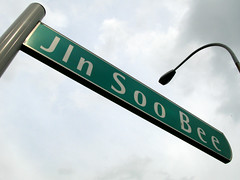
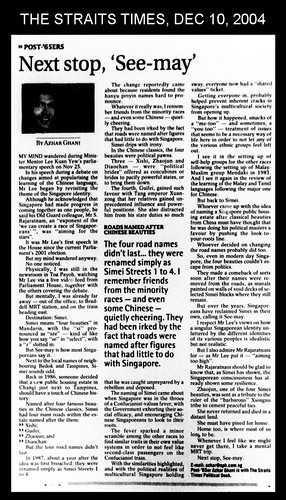


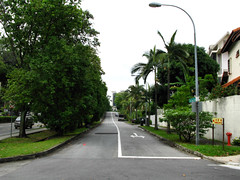
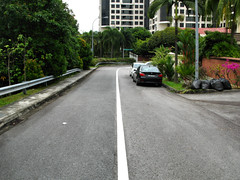

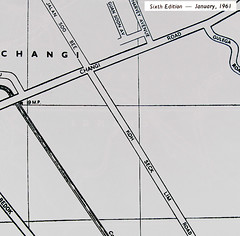

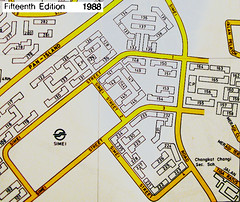










11 comments:
You are wrong about Jln Soo Bee. I checked my 1993, bilingual street directory. In Chinese it is 惹兰四美. So obviously it is not a Hokkien name.
I think the reason you cannot find any other roads named after the 4 classical Chinese beauties is because Soo Bee was proabably the name of a prominent person; like Nee Soon was named after Lim Nee Soon.
No doubt Jalan Soo Bee is 惹兰四美. I'm not sure whether 'Soo Bee' is Hokkien, but 'Bee' should be Hokkien for 美. The problem is with the "Soo".
hi just passing thru :)
Thanks Liying!
Dear Icemoon, "Soo" is the literal pronunciation of "四". "See" is the vernacular.
Thanks Anon for surfacing this post 3 years after the last comment.
However I'm a bit confused by the literal pronunciation "Soo". Is this some kind of dialect?
Great post! (coming from a resident who'd been wondering where the name 'Simei' came from)
And to clarify your question, 'soo' is the literary pronunciation (not literal, as anonymous posted), while 'see' is the vernacular / colloquial pronunciation of the word.
There is a reason for the difference - in many languages you have a situation called 'diglossia' (http://en.wikipedia.org/wiki/Diglossia) where you have a spoken vernacular form and a written literary form that are quite different from each other. The written literary form is generally used in more formal settings and in literature while the colloquial one is used everyday conversation. Usually the literary form represents an older form of the language, or an approximation of that older form - the pronunciation of words in the same language can and will change over time. Or it may be a more prestigious variety of the same language, associated with sophistication and education (but not suitable for everyday communication with family and friends).
For instance, many Singaporeans may write emails / essays / blog posts in 'standard English' and some may even pronounce (or attempt to pronounce) words closer to British Received Pronunciation when reading words aloud. However in normal conversation, they would probably just switch to the more vernacular Singlish pronunciation. (Although admittedly, not many people can switch so easily.)
On a side note, a friend of mine commented that when he was learning to give phone numbers in Taiwanese (which is closely related to Singaporean Hokkien), he would have to use the literary forms of the numbers. This doesn't seem to be a feature of Singaporean Hokkien, and I don't think many Hokkien & Teochew speakers here are familiar with the literary forms.
Hope that clears things up!
There is a mention of this prominent figure in the early 20th century called Tan Soo Bee 陈四美 on the history placards in Changkat Changi Secondary Sch. You can try starting from there too!
Thanks, didn't know there is such a person :)
Hi icemoon, I am very intrigued by the comprehensiveness of your research on simei and Jalan Soo Bee! My great grandfather was tan soo bee (陈四美)and your research corroborates with the stories my grandfather has told me about the road. Pls reply so that we can discuss more about it :)
hello beverley
The Changi Simei Community Club is hosting a history exhibition on Simei and Mr Tan Soo Bee, do you mind if the CC contacts you for more information?
Post a Comment